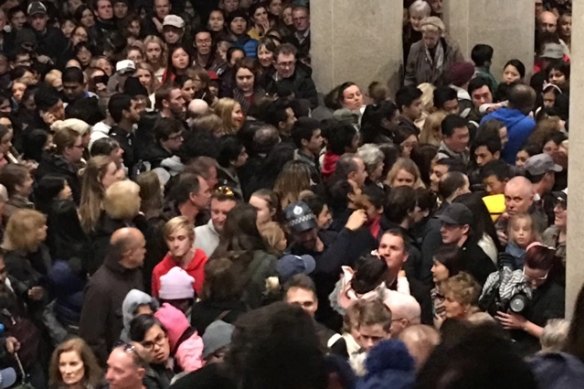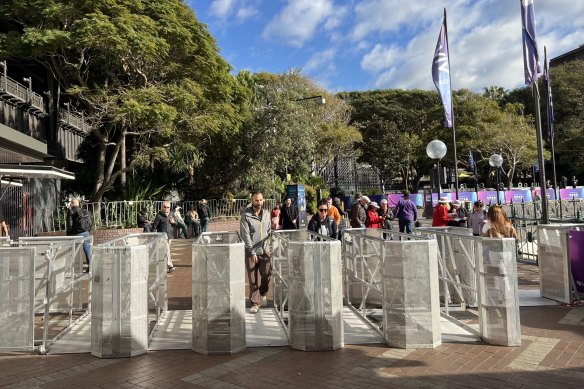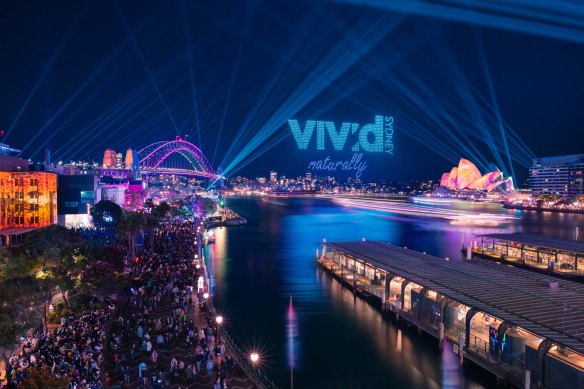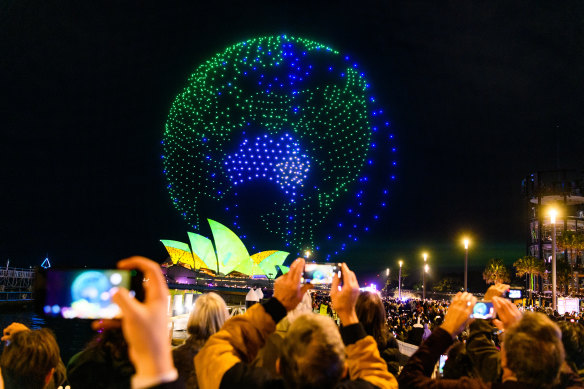- Exclusive
- National
- NSW
- Vivid Sydney
This was published 10 months ago
Two dangerous choke points, two near misses. Vivid’s crowd crush problem
On Saturday night, Vivid Sydney came close to disaster. Thousands of festival-goers leaving a drone show became trapped by a bottleneck caused by a barrier on the western side of Circular Quay.
Social media posts from people within the crowd described it as the scariest thing they had experienced as people were “pushed from all sides with no escape”.

Masses of people get caught in the crowd during Vivid 2016.Credit: Patricia Anderson
The intensifying popularity of the festival of lights has led to concerns of a catastrophic and potentially deadly crowd crush.
And while NSW Premier Chris Minns vowed that the government-owned festival would “do better” after Saturday’s incident, it’s not the first time Vivid has been the site of a near disaster.
On the night of Saturday, June 11, 2016, the eastern side of Circular Quay was overwhelmed with people.
A choke point resulted from large crowds moving in opposite directions to and from the Opera House as many tried to escape up the narrow Moore Stairs.
Mark Southcott, who found himself in the packed crowd while visiting Vivid with his wife, said they were in “serious danger” for at least 20 minutes as the trapped throng was “freaking out and screaming”.
Southcott vowed never to return to Vivid and, after hearing of Saturday night’s events, foreshadowed “a horror there one night.”
The 2016 event was explained by the single entry point to the Botanic Gardens attraction, the gate in the Opera House forecourt. This led to heavy pedestrian traffic up and down eastern Circular Quay.
In later years, more gates were opened to mitigate this risk and the one-way flow Vivid Light Walk was introduced. But this second incident eight years later suggests there are still lessons to learn.
Devastating effects of crowd crushes
UNSW academic Dr Milad Haghani, a crowd safety expert, said it’s important not to sensationalise the term “crowd crush”. Haghani said what happened on Saturday night and in 2016 are better described as “near-misses”.
The scientific definition of a crowd crush is when crowd density reaches nine to 10 people per square metre, and this number is sustained for a significant amount of time.
While there were no reported injuries in 2016 or on Saturday, a true crowd crush can be devastating.
In 2022, 159 people were killed in Seoul, South Korea, when poor crowd management led to a crush in a narrow street on Halloween night.

The temporary barriers erected on the western side of Circular Quay train station, with the lighter barricades along the path seen in the background.
The crowds on Saturday night didn’t reach those levels. But Haghani said a density of six to seven people per square metre can make people feel uncomfortable or even panicked and can rapidly escalate to a crowd crush.
“If the density increases for a sustained time as the crowd keeps flowing into a bottleneck, and there’s no alleviation like the removal of the barriers, then that’s when you have a crush,” he said.
The cause of Saturday night’s bottleneck was a temporary barrier erected on the western end of Circular Quay train station for the duration of Vivid. The metal structures disperse crowds by forcing them into single files. The crowd was only freed when someone started removing lighter barricades lining the pathway.
But Haghani said that this form of crowd control was based on 20-year-old science that has been debunked.
“Putting obstacles in front of the crowd gives the illusion that [organisers] are doing something, it makes you feel good in terms of crowd management,” he said.
“But scientifically speaking, it interferes with the flow of the crowd. It either has no impact on the flow efficiency or has a detrimental impact depending on how they are placed.”
Haghani said that if barriers like these were employed, they should at least be “easily expandable or removable” to accommodate unexpectedly large crowds.

Vivid’s popularity is helped by it being free amid the cost of living crisis.Credit: Destination NSW
Vivid presents unique challenges
A spokesperson for Destination NSW, the organisers of Vivid, said: “Multiple agencies are involved in monitoring the crowd and traffic flow and implement flexible measures to manage congestion, including infrastructure such as fencing and bollards and road and station closures.”
“Learnings from previous years are incorporated into operational measures in 2024”.
Vivid presents unique challenges, Haghani said, with “the characteristics of the most complex form of crowd management, along with New Year’s Eve”.
“They are unticketed events, held across a very large amount of space, and the demand is unpredictable,” he said.
“The problem is that there is a very specific point in time after which the crowd is not interested any more and wants to go home, as is the case with the end of the drone show or the fireworks.”
However, given the popularity of Circular Quay, Haghani said it was unavoidable that crowd events would be held there and remained confident that good crowd management was achievable.
He suggested using better crowd management techniques, such as employing security guards to direct crowds rather than physical barriers and encouraging people to stay at the festival beyond the end of the drone show.
John Gilly, the author of the Sydney Spectaculars event blog, has been covering Vivid in detail for years and foreshadowed future crowd incidents after the 2016 near-miss.
Gilly noted in his blog there were six drone shows in 2023 that attracted around 70,000 patrons each.

A drone show over the Opera House at last year’s Vivid festival.Credit: James Brickwood
Meanwhile, only three drone shows were scheduled in 2024, two of which were last weekend, with the third this Saturday.
The concentration of the crowds interested in seeing the drones into half the number of nights created a potentially predictable surge in crowd size that Vivid could have prepared for in advance or avoided completely by scheduling more shows.
Chris Minns identified other contributing factors, including the good weather and the event’s free nature amid the cost-of-living crisis.
Start the day with a summary of the day’s most important and interesting stories, analysis and insights. Sign up for our Morning Edition newsletter.